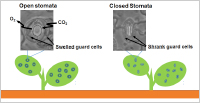Stomatal pores are formed by pairs of guard cells, and closing and opening pores are regulated by guard cell volume changes. Stomatal pores are gateways for regulating gas exchange for photosynthesis. When guard cells swell, stomata open. On the other hands, when guard cells shrink, stomata close.
Enlarge Image Figure 2 :
(Left) Methionine induces Ca2+ influx channel activation in wild-type plants (upper trace) but not in the mutant lacking GLR3.1/GLR3.5 (Lower trace). (Right) A simplified model indicating the role of GLR3.1/3.5 Ca2+ channel and methionine to trigger stomatal closure in Arabidopsis plants.
Enlarge Image
Plants use methionine to respond to environmental stresses
Evidence of the new physiological role of glutamate receptor homologs (GLRs) - plant proteins that share ancestral roots with those in our neural system - has been presented by an international collaboration with researchers at Okayama University.
Neural communication, learning, and regulation processes in humans are mediated by glutamate receptors, a type of protein that responds to an amino acid neurotransmitter, glutamate. It has been known that homologs of the glutamate receptors (GLRs) exist in plants, but the detail functional characterisation remained to be done. Now Drs. Dongdong Kong, Heng Cheng Hu, Eiji Okuma, and collaborators in the US, China, Japan, and Korea have demonstrated for the first time that two types of GLR found in Mouse-ear cress (Arabidopsis) - GLR3.1 and GLR3.5 - do form ion channels as animal glutamate receptors, - but they respond to methionine, instead of glutamate.
Calcium ion is known to be crucial in the opening and closing of tiny pores on leaf surface, called stomata, which regulate gas exchange for photosynthesis. Kong, Hu, Okuma et al. found that GLR3.1 and GLR3.5 function as methionine-activated calcium ion influx channels that regulate stomatal closure response. They found that Arabidopsis mutant plants lacking GLR3.1 and GLR3.5 showed impairment of methionine-triggered calcium ion currents and stomatal closing. These results identified the new role of methionine as a regulator in plant stress responses.
Previous studies had revealed that reactive oxygen species (ROS) function as second messengers in regulation of stomatal closure. Kong, Hu, Okuma et al. provided evidences that GLR3.1 and GLR3.5 calcium ion channels act independently and upstream of ROS. The authors conclude, “it will be of interest to explore the potential interplay and intrinsic characteristics between the redox-sensitive signalling pathways and the GLR3.1/3.5 channel-mediated Ca2+ signalling pathway in plants.”
Publication and Affiliation:
Dongdong Kong 1,2,3,9, Heng-Cheng Hu 1,9,10, Eiji Okuma 4,9, Yuree Lee 5,9, Hui Sun Lee 6, Shintaro Munemasa 4, Daeshik Cho 1, Chuanli Ju 7, Leah Pedoeim 1, Barbara Rodriguez 1, Juan Wang 7, Wonpil Im 6, Yoshiyuki Murata 4, Zhen-Ming Pei 2, and June M. Kwak 5,8,11,*, L-Met activates Arabidopsis GLR Ca2+ channels upstream of ROS production and regulates stomatal movement. 2016, Cell Reports 17, 2553–2561
http://dx.doi.org/10.1016/j.celrep.2016.11.015
- Department of Cell Biology and Molecular Genetics, University of Maryland, College Park, MD 20742, USA
- Department of Biology, Duke University, Durham, NC 27708, USA
- Department of Chemistry, Capital Normal University, Beijing 100048, China
- Graduate School of Environmental and Life Science, Okayama University, Tsushima-Naka, Okayama 700-8530, Japan
- Center for Plant Aging Research, Institute for Basic Science, Daegu 42988, Republic of Korea
- Department of Biological Sciences and Bioengineering Program, Lehigh University, 111 Research Drive, Bethlehem, PA 18015, USA
- College of Life Sciences, Capital Normal University, Beijing 100048, China
- Department of New Biology, DGIST, Daegu 42988, Republic of Korea
- Co-first author
- Present address: American Genome Center, Uniformed Services University of the Health 0Sciences, Bethesda, MD 20814, USA
- Lead Contact
*Correspondence: jkwak@dgist.ac.kr


